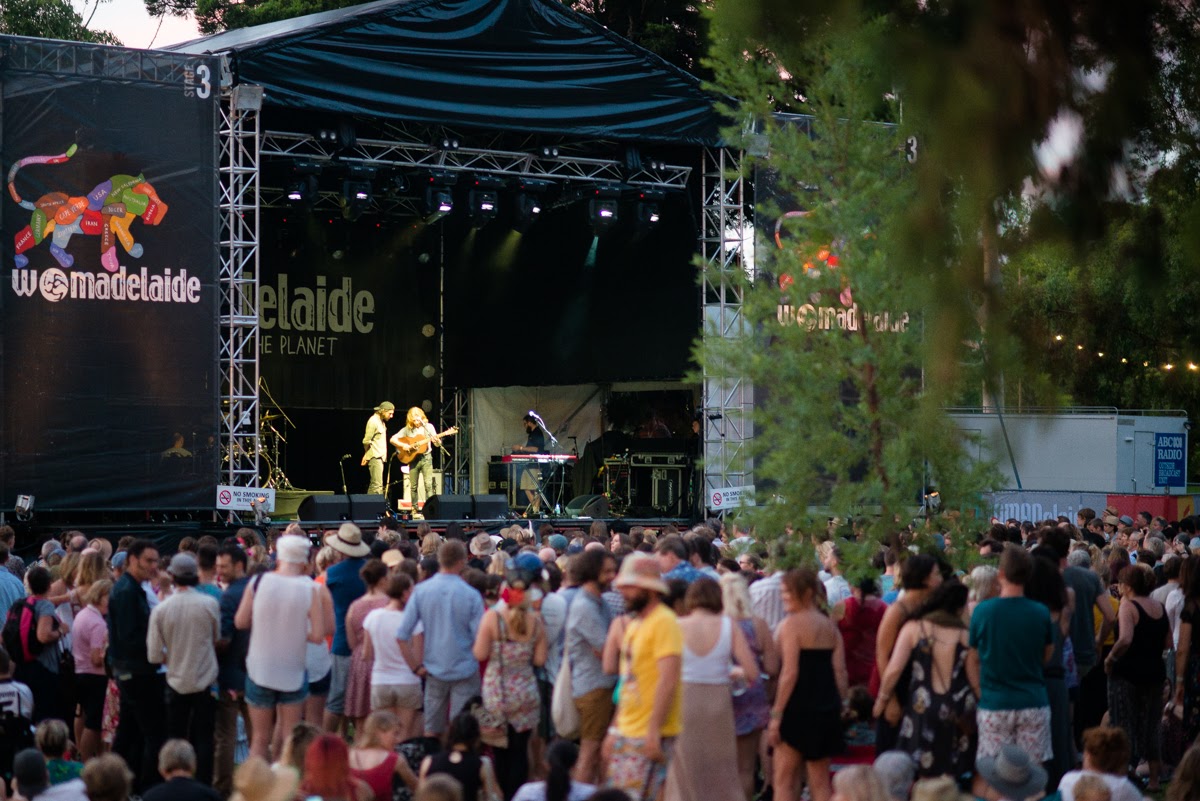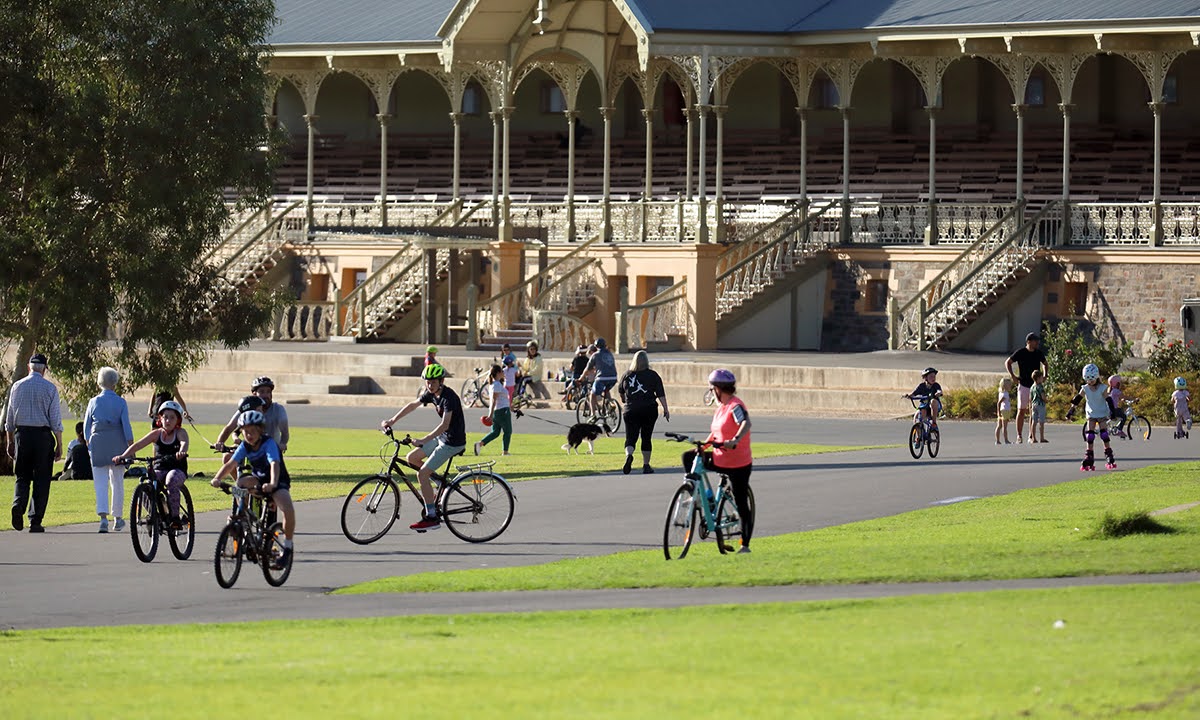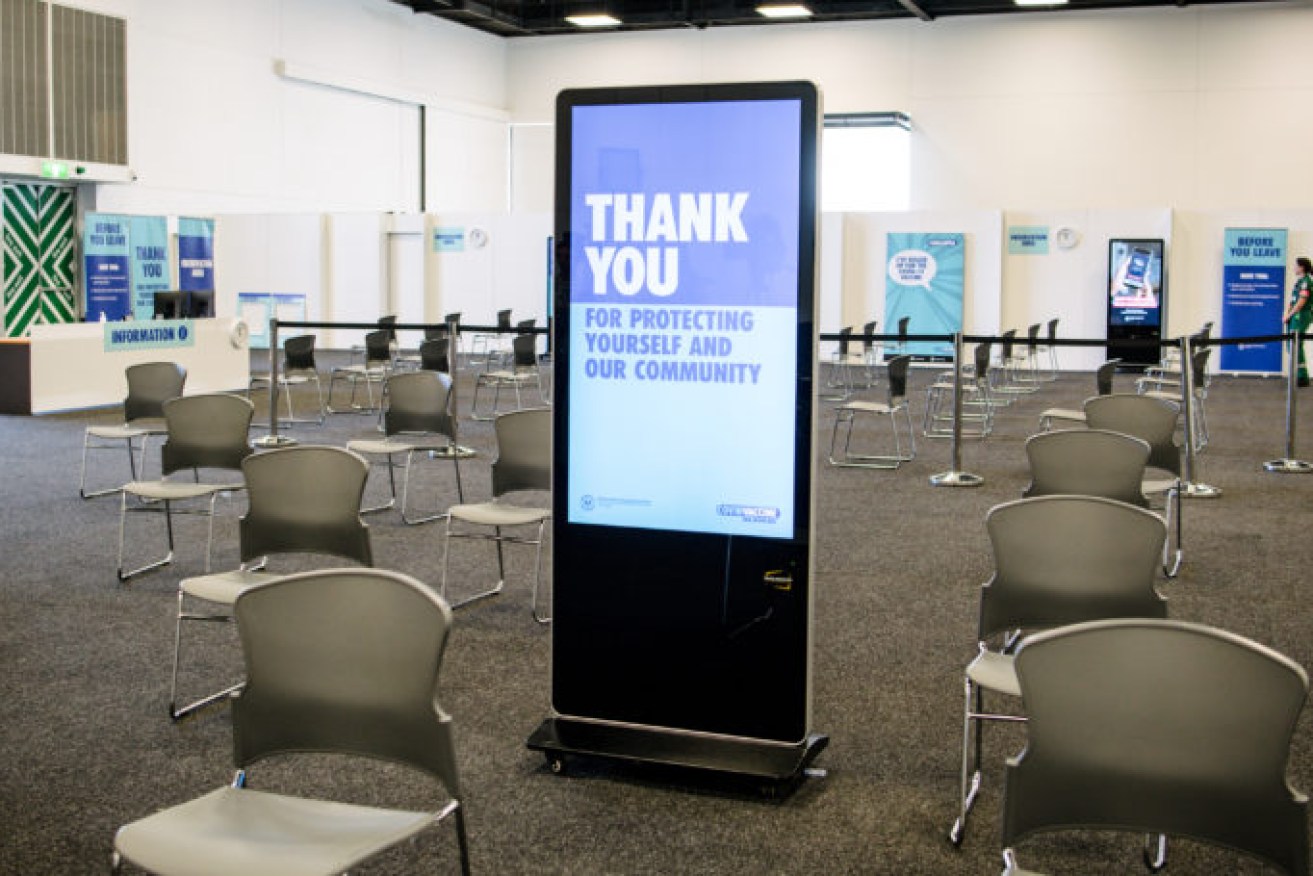- Australia hits 70 per cent double-vax milestone
- SA cricketers in alleged COVID-19 breach
- NSW reports 283 new cases, seven deaths
- Vic records 1841 new cases, 12 deaths
- Fire bans in SA ahead of hot, gusty conditions
- WOMADelaide back in Botanic Park in 2022
- Regional development grants went to cities
- Young people increasingly exposed to terrorism: ASIO
- Cycling provides $6 billion boost to economy
Australia hits 70 per cent double-vax milestone
Australia has reached a significant milestone, with 70 per cent of people aged 16 and over fully vaccinated as a booster rollout draws closer.
More than 85 per cent of Australians aged 16 and over have now received at least one jab and 70 per cent two doses.
Aged care residents are expected to start receiving third jabs from the second week of November if the medicines regulator and expert immunisation panel approves the move.
Health Minister Greg Hunt said he would have a critical meeting about booster shots on Monday.
“We’re ready, we’re in a position to commence and to make sure that additional protection is provided,” he told reporters in Canberra on Wednesday.
The Therapeutic Goods Administration and Australian Technical Advisory Group on Immunisation are weighing up advice to government.
Hunt expects the booster program for the wider population to start this year.
Chief Health Officer Paul Kelly said older people and aged care residents who were initial rollout priorities could be the first recipients.
“They will be the first in line because they are now six or more months after that second dose,” he said.
“It’s likely they will be the first ones to get it but let’s see what ATAGI comes back with.”
Professor Kelly met with ATAGI on Tuesday when evidence from booster programs around the world was considered.
“We are able to look at the data that had come out from Israel,” he said.
“It very much confirms this is safe, it is effective in all age groups for both decreasing infection as well as severe disease and, for the older age groups, prevention of death.”
About 500,000 people with severely compromised immune systems are already eligible for a third shot.
Australian Medical Association Victorian president Roderick McRae urged the expert immunisation panel to approve third jabs.
“The vaccine status of those healthcare workers in particular who have had those two booster doses, their protection against COVID-19 is waning,” he said.
“They should be looking after healthcare workers to ensure that they’re as protected as they possibly can be as they have made the decision to open up the community.”
SA cricketers in alleged COVID-19 breach
Ten South Australian cricketers who were evicted from a nightclub are under investigation for alleged breaches of COVID-19 rules.
Police evicted the Redbacks cricketers from the Cry Baby nightspot in Adelaide’s central business district about 12.30am on Tuesday.
The players allegedly refused orders from the nightclub’s security staff to stop dancing and reportedly were verbally abusive to staff.
Under SA’s COVID-19 regulations, dancing is banned in licensed venues.
While no charges were laid by police, the South Australian Cricket Association (SACA) is investigating.
“SACA has been made aware of an allegation that several Redbacks players were asked to leave a city venue following concerns about their behaviour,” SACA said in a statement.
“While SACA has not received a formal complaint from any party, the details and circumstances surrounding the allegations are currently being investigated.
“As an organisation, SACA is committed to maintaining the highest standards of behaviour both on and off the field and expects all its personnel to adhere to current COVID-19 restrictions in the interest of community safety.”
The group of Redbacks players went to the nightclub after their drawn Sheffield Shield game against Queensland ended on Monday.
NSW reports 283 new cases, seven deaths
NSW has reported 283 new locally acquired cases of COVID-19 and seven deaths as the state prepares to resume non-urgent elective surgery next week.
In the 24-hour reporting period to 8pm on Tuesday, 92.3 per cent of people 16 and older have had one dose of a COVID-19 vaccine while 81.6 per cent of people are fully vaccinated.
There are 552 people in NSW hospitals with COVID, 124 of them in ICU.
Non-urgent elective surgery will resume in Greater Sydney next week after a two-month hiatus during the height of the recent COVID-19 outbreak in the state.
NSW Health says high vaccination rates and falling case numbers mean it can safely give the green light to overnight elective surgery, which was suspended on August 2 in public hospitals and three weeks later in private hospitals.
Surgeries will be capped at 75 per cent capacity at public and private facilities within Greater Sydney, including the Nepean Blue Mountains region from Monday.
Day surgery returned on October 5 across both public and private systems.
Vic records 1841 new cases, 12 deaths
Victoria has recorded 1841 new locally acquired COVID-19 cases and 12 deaths, as the state opens its borders to fully vaccinated people from Sydney without quarantine on arrival.
The health department confirmed the state now has 22,598 active cases.
There were 78,928 tests processed and 38,881 COVID-19 vaccine doses administered at state-run hubs on Tuesday.
The new deaths take the toll from the current outbreak to 175.
From midnight on Tuesday, there are no more red zones in NSW, with greater Sydney now an orange zone.
Travellers from the Greater Sydney region, including the Blue Mountains, Central Coast, Shellharbour and Wollongong, will still need an orange zone permit to enter Victoria.
But the rules will be different for people who are not fully vaccinated.
They will have to isolate on arrival, get tested within 72 hours, and remain in isolation until they receive a negative result.
The rest of NSW will become a green zone, but travellers still need a permit.
Fire bans in SA ahead of hot, gusty conditions
Total fire bans have been declared for parts of South Australia as authorities gear up for hot and windy conditions forecast across the state.
Today’s fire bans are the first ahead of South Australia’s upcoming bushfire season, with the Northwest Pastoral, West Coast and Eastern Eyre Peninsula districts all rating “severe” on the fire ban scale.
The Country Fire Service has recommended that people living in those districts implement their bushfire survival plan, or leave their properties early before a fire starts.
The fire bans will last until midnight tonight.
Elevated fire danger tomorrow over the north and west of #SouthAustralia! Hot to very hot with fresh to strong and gusty northerly winds ahead of a cooler strong and gusty west to southwesterly change in the afternoon and evening. Fire Weather Warning https://t.co/7bRg0cSSe0 pic.twitter.com/JNgHhHYP0J
— Bureau of Meteorology, South Australia (@BOM_SA) October 19, 2021
It comes as the Bureau of Meteorology forecasts gusty thunderstorms in the west and northwest and hot conditions in the north ahead of a gusty and strong southwesterly change.
The bureau warns gale force winds could extend over the pastoral districts following the change, with a severe weather warning in place for the northwest and northeast pastoral districts.
Severe Weather Warning for DAMAGING WINDS
For people in parts of North West Pastoral and North East Pastoral districts.
Issued at 4:48 am Wednesday, 20 October 2021.The next Severe Weather Warning will be issued by 11:00 am ACDT Wednesday. refer https://t.co/84YvfmHFgc pic.twitter.com/YJbRWqGgBl
— Country Fire Service (@CFSAlerts) October 19, 2021
Adelaide is set for a top of 30C today, with a slight chance of a shower late this afternoon and evening ahead of a cool change tonight.
Remote towns including Oodnadatta could reach up to 42C, while Coober Pedy and Roxby Downs can expect to reach 39C.
Today’s hazardous fire conditions come as the CFS warns a large number of South Australians don’t know where to find a safe place in the event of a bushfire.
Data collected by the CFS last summer from people living in bushfire-prone areas found that 42 per cent didn’t know the meaning of a safer place or where to find one.
“Despite the fact that we’ve had catastrophic bushfires in our state over recent years, it’s quite worrying to know that people don’t fully comprehend the concept of our established bushfire safer places,” CFS spokesman Joel Taggart said.
“More often than not, they get confused with a bushfire last resort refuge which should not be used unless there is absolutely no other option.”
“In many cases, this safer place will be the metropolitan Adelaide area or a large rural town.”
The RAA says bushfires have burnt 400 South Australian homes causing more than $41 million of damage since 2015.
WOMADelaide back in Botanic Park in 2022

Photo: InDaily
WOMADelaide will return to Botanic Park in its usual seven-stage format in March next year, but organisers says artists, festival-goers, staff and stallholders must all be fully vaccinated for COVID-19.
After pandemic restrictions saw the annual world music festival reimagined as a series of four seated sunset concerts in King Rodney Park / Ityamai-itpina this year, director Ian Scobie says he is thrilled it will be able to celebrate its 30-year anniversary in the park where it has been held since the first WOMADelaide in 1992.
He told InReview that the maximum daily capacity in Botanic Park will be reduced from 25,000 a day to 18,000 a day.
Everyone on site who is aged over 16 – including members of the public, artists, staff, volunteers and stallholders – must be double vaccinated, with a check box advising ticket buyers that this is a requirement for attending.
“Essentially, in going back to Botanic Park, albeit with reduced capacity to 18,00 a day… we just feel that from an OH&S point of view – both in terms of the staff and artists and audience – that we must make a blanket rule that essentially anyone at the event has to be fully vaccinated,” Scobie says.
Read the full story in InReview.
– Suzie Keen
Regional development grants went to cities
More than half of the federal government’s regional development grants awarded since 2018 went to postcodes classified as major city areas.
They represented $624 million or 27 per cent of the total value of the grants from the start of 2018 until June 30 this year.
The Australian National Audit Office analysed government grant awards or opportunities posted to its GrantConnect portal during that time.
Of the 6668 grants awarded, 3682 went to postcodes classified as major city areas.
Going by grant value, $860 million or 37 per cent of the total funding was awarded to inner regional areas.
Areas classified as being outer regional received $521 million or 23 per cent of the money.
A combined eight per cent of the total grant value, or $161 million, was allocated to remote or very remote areas.
Looking at the value of all 108,206 grants published, 42 per cent were awarded through a closed non-competitive tender process.
Labor has used the data to further its attack on the coalition, under fire for pork-barrelling via the Building Better Regions Fund and commuter car park funding.
“The Morrison-Joyce government talks a big game when it comes to regional development, but these figures show that they continually favour projects based in the major cities,” opposition infrastructure spokeswoman Catherine King said.
A Labor analysis earlier showed $218 million or nearly 73 per cent of the fifth round of the Building Better Regions Fund went to coalition seats.
When non-coalition marginal seats were factored in, the figure rose to 88 per cent.
The government has defended the funding as addressing the disparity in investment between capital cities and regional Australia.
In the lead up to the 2019 election, the government used a list of “top 20 marginals” to guide its $660 million fund for car parks at train stations.
The auditor-general found the fund was poorly administered and projects were not based on need.
Young people increasingly exposed to terrorism: ASIO
The COVID-19 pandemic has increased young people’s exposure to extremist propaganda, creating an unprecedented online audience, the Australian Security Intelligence Organisation warns.
The country’s top security agency identified people under the age of 18 involved in violent extremism and warned that minors had not only conducted terrorist attacks, but held leadership positions in terrorist groups.
“Violent extremist narratives … particularly appeal to teenagers, and may resonate with some minors’ feelings of alienation, unease about the future and mistrust of adults,” it said in its annual report released yesterday.
Australia’s terrorism threat remains at probable, meaning there is intelligence to suggest people in the country have the motivation and ability to carry out an attack.
Future terrorist attacks in Australia are likely to be undertaken by lone wolves using simple weapons to target public spaces, making them harder for security agencies to detect.
There were two terrorist attacks by lone actors who used simple weapons in 2020/21 and three major attacks were prevented in the past year.
ASIO says this kind of attack is difficult to detect as it can arise with little forewarning.
But espionage and foreign interference are expected to leapfrog terrorism as Australia’s primary security concern over the next five years.
ASIO director-general Mike Burgess said the number of attack attempts from foreign spies was “unacceptably high”.
“These attempts occur on a daily basis,” he said.
Foreign actors are also monitoring, coercing and threatening people from certain cultural communities within Australia but no county was named in the annual report.
Cycling provides $6 billion boost to economy

Photo: Tony Lewis/InDaily
Cycling in Australia contributed about $6.3 billion in 2020 and boasts a booming participation rate, a report to be launched by the Federal Treasurer has found.
Prepared for We Ride Australia, the report says cycling directly supports 34,295 jobs across the country.
More than 4.6 million people ride a bike in a typical week, and more than 10 million rode at some stage in the past year.
In 2020, about 1.7 million bikes were purchased, worth about $1.5 billion, with 28 per cent of those bought for children.
The report also highlights the growth in cycle tourism, estimated to be worth more than $1 billion annually.
But it also identified the lack of bikeways in urban areas, a need for more off-road trails and the number of heavy vehicles on the roads as the biggest barriers to people riding more.
It will be launched on Wednesday by federal Treasurer Josh Frydenberg.
We Ride Australia Director for National Advocacy Stephen Hodge said bike riding touched almost every family in every community.
“The full economic value of the sector is even greater when we include the economic benefits of improved health, environmental benefits or the positive impact on traffic congestion from more people riding,” he said.
“With an increasing burden of chronic disease related to physical inactivity and transport congestion costing the country billions of dollars annually, it is now clear that the bicycle sector has the capacity to address these issues of concern nationally while also assisting the transition to a lower emission transport fleet.”
– with AAP and Reuters





